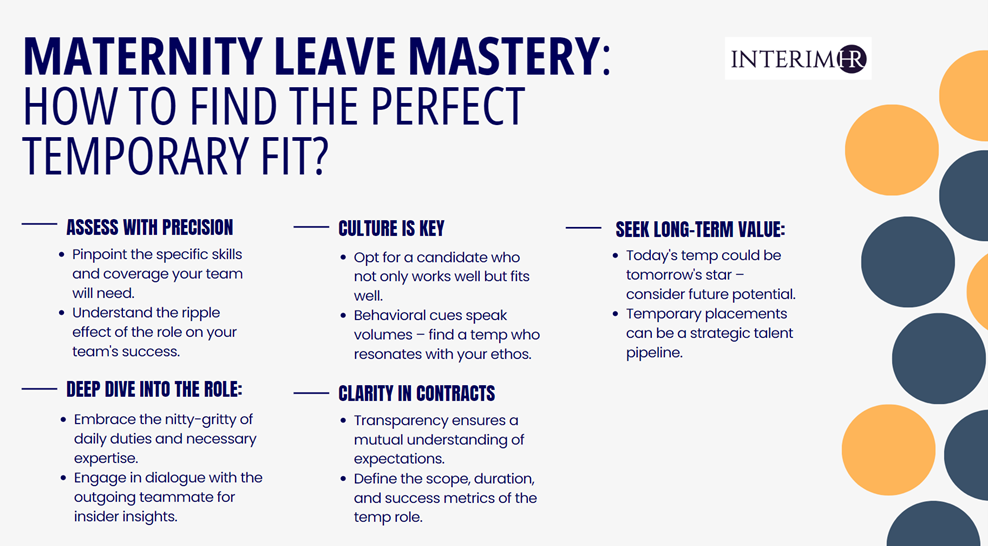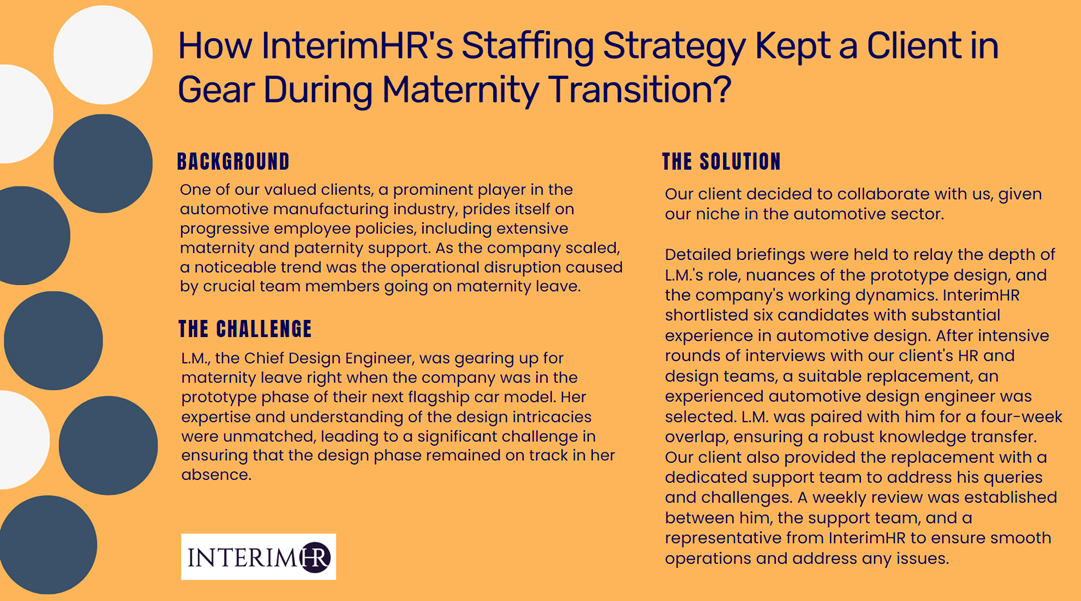How to Maintain Productivity with Zero Maternity Leave Disruptions
 As indispensable team members take time off to start or grow their families, businesses must employ innovative staffing strategies to ensure continuity and preserve momentum. This blog delves into the smart solutions that forward-thinking companies are adopting to seamlessly bridge the gap left by maternity leave, ensuring operations run smoothly and productivity remains high.
As indispensable team members take time off to start or grow their families, businesses must employ innovative staffing strategies to ensure continuity and preserve momentum. This blog delves into the smart solutions that forward-thinking companies are adopting to seamlessly bridge the gap left by maternity leave, ensuring operations run smoothly and productivity remains high.
Read on!
Every year female employees go on maternity leave creating a huge gap in the organization as it temporarily removes a key team member whose skills and expertise drive critical operations. While welcoming a child is a matter of great joy for the new parents, the employers, however, experience disruption in workflow and team dynamics. Many times there are issues that aren’t even talked about, so, before exploring staffing strategies to address this, it's important to acknowledge the less-discussed challenges that arise during such breaks –
Challenges of Maternity Leave
Workflow Disruption, Knowledge Transfer, and Communication Hurdles
- Workflow disruption: When a key employee takes maternity leave, it can significantly impact an organization's productivity and the smoothness of its operations. This is primarily because such employees hold specialized knowledge and carry pivotal roles that take time to replace immediately. Their departure can create a knowledge gap, leaving remaining team members with extra responsibilities, which creates a potential gap in workflow. In a situation like this - redistribution of workload helps, but it massively increases stress and lowers employee morale if not managed carefully. Additionally, the transition period also leads to a temporary decrease in productivity as the team takes time to adjust to the new arrangement.
- Knowledge transfer issues: This is one of the most common challenges a client may face during the maternity transition. If the knowledge and responsibilities of the departing employee are not well-documented, transferring their expertise to other staff members can be tricky. It may even result in a loss of efficiency as other team members try to fill the gap without the necessary information or understanding of nuanced processes. Such issues aggravate further if there is insufficient time for a handover or if the replacement staff needs more context to assimilate complex duties.
- Rebuilding trust and rapport: When a key staff member goes on maternity leave, rebuilding trust and rapport becomes necessary, and the organization's leaders must come forward to facilitate that. Clients who were once accustomed to the expertise of the departing employee may take a while to get used to the workings of the new team member and place them on the same pedestal. The rearrangement may also demand reassessment as trust is built through consistent performance and engagement.
- Potential financial implications: The costs associated with recruiting and training temporary staff can lead to increased labor costs. Suppose the temporary replacement (when not hired by an agency) is unable to perform tasks with similar dedication and accuracy. In that case, productivity may decline, impacting revenue, especially if the role is tied to the company's income-generating activities. Additionally, if the transition leads to decreased client satisfaction, it could result in losing business or client trust, potentially affecting long-term revenue streams. The financial impact, while often temporary, can be significant and requires strategic planning to mitigate.
- Communication Challenges: Sometimes, the employee going on maternity leave may serve as a critical communication hub, facilitating information flow between different departments or with clients. In their absence, messages can become delayed or misinterpreted, leading to errors or inefficiencies. Their colleagues or peers (filling in) may not be privy to existing communication or share the same rapport with clients and colleagues, which can result in misunderstandings or a lack of coordination.
Strategic HR Temp Solutions
How HR Temp Staffing Bridges the Maternity Leave Gap with Efficiency and Expertise?
- Filling the productivity gap: When a key employee goes on maternity leave, there's an immediate productivity gap that needs to be filled to maintain the operational pace. Temp staffing can swiftly bridge this gap by providing skilled professionals who can jump in and take on the required duties. Often, these temps have the right experience and skills from handling previous roles, making them adept at adapting to new environments quickly. By doing so, they keep projects moving forward and help meet deadlines, mitigating any lags in productivity.
- Minimizing Overburden on Existing Staff: Temp staffing alleviates burnout by ensuring that the workload is distributed more evenly. Temporary workers can take on significant chunks of the workload, preventing the remaining permanent staff from becoming overburdened. This approach helps maintain a healthy work environment and ensures that employee satisfaction and morale remain high, which is critical for retaining talent.

- Ensuring business continuity: Temporary workers ensure that all functions continue to operate smoothly, and service levels remain unchanged. This is particularly important in maintaining client satisfaction and trust, as clients may not even notice the change in personnel due to the maintained quality of work and service.
- Less training required (compared to ones not hired from a staffing agency): Temporary workers hired from reputed staffing agencies (such as ours) often require less training. They're typically accustomed to quickly adapting to new work environments and may already possess the specific skill set needed for the role (thanks to our stringent selection criteria). This reduces the time and resources spent on training and allows for a more efficient transition, ensuring that productivity levels are upheld without a significant learning curve.
- Quick Integration and Specialized Skills: Temporary workers are not just stop-gap solutions; they bring with them specialized skills that can be advantageous to the team. Their varied experience can introduce fresh perspectives and efficiencies to projects. With a focus on quick integration, these professionals are adept at getting up to speed with team dynamics, project requirements, and company culture, contributing to the organization’s needs from day one.

If you are looking to streamline your hiring process, then collaborating with a temp staffing agency can be highly beneficial. These agencies hold expertise in filling critical positions on an immediate basis, which enables quick turnaround, thereby minimizing disruptions in the workforce. Moreover, partnering with a staffing agency is cost-effective. They take the entire load off you and handle the employment process (end-to-end). Additionally, they offer guarantees and flexibility, which are unlikely to be found in the traditional hiring processes. Temporary staffing agencies also provide replacement options without any additional cost if a particular candidate does not fit.

Seamless Integration
What Are the Best Practices for Transitioning Temp Staff During Maternity Periods?
To ensure seamless transitioning of temporary or contractual staff during the maternity period, it is extremely crucial to implement a set of best practices that safeguard productivity and maintain team cohesion. Some of the best practices that you can implement are –
- Comprehensive Knowledge Transfer Sessions: Ensure outgoing employees conduct detailed handovers to interim staff, covering all critical aspects of their roles.
- Assign a Point of Contact or Mentor: Designate a knowledgeable insider to guide the contract worker or temp staff through their tenure, providing support and answering questions.
- Regular Check-ins and Feedback: Schedule consistent meetings to review the temp staff's progress, resolve issues, and adjust to feedback for continuous improvement.
- Provide Access to Necessary Resources: Equip the replacement with full access to required tools, systems, and information to enable them to perform their job efficiently.
- Foster an Inclusive Team Environment: Encourage a welcoming team culture that supports and integrates the temp staff, promoting effective teamwork and collaboration.
The strategic use of a contractual workforce during maternity leaves has proven to be an indispensable component of modern workforce management. It not only ensures that business operations continue unimpeded but also reflects a commitment to inclusivity and support for employees during pivotal life events. Looking ahead, businesses that aspire for growth and sustainability must embrace these flexible staffing solutions as a standard practice. This forward-thinking approach is what will distinguish industry leaders in the ever-evolving landscape of work.
Looking to maintain momentum during maternity leave periods without missing a beat? InterimHR is your answer. Reach out to us and discover how our temp staffing solutions can keep your business thriving and your team supported.
IHR cannot and does not provide legal advice. It’s important to consult with qualified counsel before adopting any new policies. It’s also your responsibility to determine whether legal review of work product is necessary prior to implementation.
